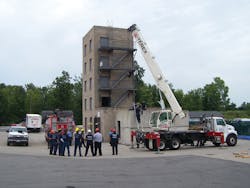This is the second installment of a series of articles about the creation of a state-of-the-art technical rescue training center – the Monroe County, NY, Public Safety Training Facility (PSTF) – and the events that helped make the vision a reality. Part 1 described how, despite the challenges of shrinking budgets, members of the Monroe County fire service acquired a place to train, assembled an instructional staff and staged the necessary equipment.
The first two months at the PSTF were spent in the classroom obtaining the foundation materials for the series. This consisted of the “Basic Structural Collapse Operations” course and the “Medium-Level Structural Collapse Concepts” course.
By providing the operational knowledge related to working at a structural collapse incident, the students were well prepared for the challenges they would face in their upcoming courses. These challenges would include interior and exterior shoring, breaching concrete, cutting steel, rigging and assisting in the moving of heavy materials and having to search a void space in an effort to rescue trapped victims.
Once the foundations courses were completed, it was time to start the process of putting the knowledge to use during the hands-on components. Following the New York State Collapse curriculum, the next phase was the “Rescue Technician: Basic” course. The overall objective of the “Rescue Technician: Basic” course is to improve rescuer awareness of the safety concerns at a variety of specialized rescue situations. Topics include an overview of specialized rescue; search; technical rescue management; risks and priorities; use of ropes, knots and rope systems; and establishment of landing zones for helicopter operations. This was followed by the “Medium Structural Collapse Operations (MSCO): Tools” course mentioned in part one of this series.
Next up were the shoring courses. “Exterior Shoring” was the first of the two. This program familiarized students with shoring techniques needed to safely construct multiple types of shores. Solid-sole, split-sole and flying-raker shores were taught. They also constructed flying shores, which provided a challenge to the students in not only the creation of the shore, but emphasized the importance of teamwork.
The shoring techniques taught during both the “Interior Shoring” and “Exterior Shoring” courses consume a significant volume of lumber. Part three of this series will cover one of the ways that the team who designed and constructed the Technical Rescue building and its props addressed this issue.
“Interior Shoring” was next. Using the training tower’s multiple levels allowed many different scenarios to take place simultaneously. During this course, the students learned how to construct T-shores, Double Ts and Lace Post shores using dimensional lumber. Door and Window shores, Horizontal shores and Vertical (Dead) shores were taught with both dimensional lumber and pneumatic shores. Having both dimensional lumber and pneumatic shores available lets the participants learn multiple ways to overcome the challenges they may face in the future. These options place another “slide” in their tray of knowledge.
The skills from the previous six courses were all put to the test as they entered the “Void Search and Rescue” course. Using the traveling void search simulator, the instructors created multiple challenges for the students. Not only did they have to navigate the various voids, they were required to complete additional tasks in a scenario-based manner. This format lets the students hone their skills as if they were operating at an actual incident. They had to size-up the scene and shore the exterior to make it safe for entry, then construct various interior shores to gain access to the voids. This was another true test of the students’ ability to work as a team.
Fostering Teamwork
Team building is an aspect of technical rescue training that should be reinforced throughout all training programs. The complexity and high risks associated with this type of rescue is real even during training. As mentioned previously, some things can be safely simulated during training. Movement of heavy materials, operation of powered hand tools and hot cutting activities are but a few of the real-life hazards encountered during this training that cannot be simulated. By adhering to the principle of “practicing as you perform,” you build good habits from day one.
Using the Incident Command System (ICS) and staffing models learned during earlier courses, the students were able to accomplish these challenges while constantly being observed by the instructional staff. At this stage of the collapse series, the program changes hands to a degree. Early on, the instructors took the definitive lead in all of the activities. Now, as they entered their seventh month of training, it was time to let them pull all of their skills together and function as if they were at an actual incident.
The last two courses in the series consisted of “Heavy Rigging” and “Concrete Breaching and Breaking.” The “Heavy Rigging” course worked as planned in getting the vaults moved to their desired locations for the “Concrete Breaching and Breaking” course. The crane was able to move the concrete vaults while providing the students extensive opportunities for rigging materials for a heavy lift. Due to the inherent danger of this type of operation, proper safety procedures were applied at all times.
The students gained valuable knowledge from the crane operators as to the importance of proper rigging practices. This component of a collapse operation also challenges the responders’ ability to work side by side with trained professionals from other disciplines. After the first few minutes together, it was apparent that this was going to be a successful venture. The emergency responders and the crane operators had one strong bond in common – they are hard-working people willing to go the extra mile to help someone in need.
The final course in the series, “Concrete Breaching and Breaking,” represented more than just the ninth in a series. Prior to this project, only New York Task Force 2, a state-level urban search and rescue (USAR) team, and the Fire Department of New York had completed this entire series.
As part of New York State Office of Fire Prevention and Control’s (OFPC) commitment to the training of emergency responders in New York State, an instructor certification was held in mid-August 2009. Upon the completion of the certification training, we scheduled instructors for the final course. The “Concrete Breaching and Breaking” course completed the nine-month undertaking.
Students were required to complete a number of tasks during this course. A dirty breach of concrete, a technique where the materials are removed and allowed to fall into the opening being created, was the first challenge they faced. This was followed by a clean breach; this scenario required the students to remove a section of concrete without having it fall or drop into the opening they were creating. This activity is used when live victims are possibly below or next to the area being breached.
Once again, the need to reach out for assistance arose. After the first two offerings were finished, the concrete vaults needed to be rotated in order for the last two groups to have enough working areas to complete their course objectives. Back came the heavy equipment from the airport and in one morning the training area was reset and ready for more students.
By now, the students were well versed in the various skills related to working at a collapse incident. Seeing the students interacting as one cohesive unit validated all of the hours spent preparing them for the challenges they may face in the future. Due to the efforts of all involved with this nine-month project, our community now possessed a response capability that was only a vision in the past. The first true test of bringing the “Vision to Reality” had been accomplished.
Next: Creating the technical rescue facility
BOB DUEMMEL, the technical rescue editor for Firehouse.com and Firehouse Magazine, is the host of "The Buzz on Technical Rescue" on Firehouse Podcasts. He is captain of the Special Operations Unit of the Rochester, NY, Fire Department and serves as the Plans Manager for NY TF-2. He is a member of the NYS USAR IST in the Operations Section and a member of the New York State Technical Rescue curriculum development team. He has delivered training to fire service, industrial, military and international rescue teams and has assisted with exercise evaluation for the United Kingdom and the European Union's USAR program. View all of Bob's articles and podcasts here. He can be reached via e-mail at [email protected].
About the Author
Bob Duemmel
Bob Duemmel was the technical rescue editor for Firehouse Magazine and Firehouse.com. A deputy coordinator for Special Operations in Monroe County, NY he recently retired as a captain with the City of Rochester Fire Department. Bob's involvement in technical rescue is very diverse. He is the Plans Manager for New York Task Force-2 USAR Team, a member of the Western New York Incident Management Team and a member of the New York State Technical Rescue curriculum development team. He is a nationally certified instructor with a focus on technical rescue programs. He has delivered training to fire service, industrial, military and international rescue teams and has assisted with exercise evaluation for the United Kingdom and the European Union's USAR program. Bob has also participated in numerous USAR exercised as both a participant and evaluator. He hosted “The Buzz on Technical Rescue” podcast.

